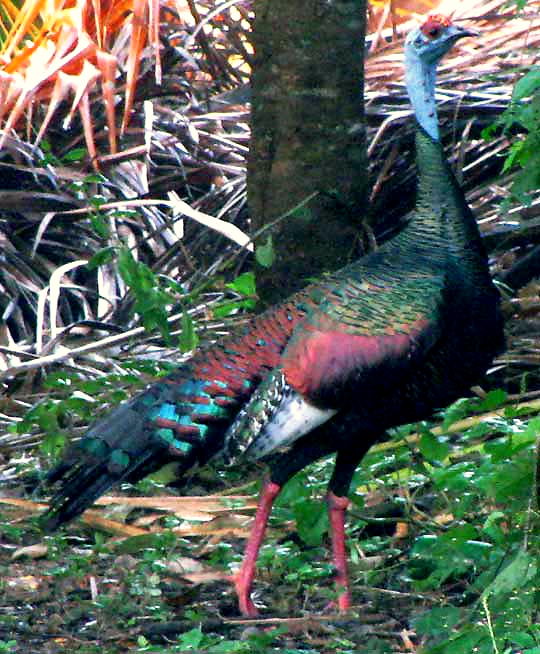Excerpts from Jim Conrad's
Naturalist Newsletter
from the October 31, 2010 Newsletter issued from Hacienda Chichen Resort beside Chichén Itzá Ruins, central Yucatán, MÉXICO; limestone bedrock, elevation ~39m (~128ft), ~N20.676°, ~W88.569°
OCELLATED TURKEY
A small band of "wild turkeys" orbits around the Hacienda, sometimes providing fleeting glimpses to visiting birders wandering the trails. In dim light of early dawn or late afternoon turkeys might even cross the grassy area below the church. Sometimes I see them every day, other times a month or two pass without their showing up. Whenever they do appear they're so restless and the light is so dim that I can't get a decent picture. This Friday morning, though, one tarried in a clearing long enough for me to get a shot only a little blurry because of the low light and consequent slow shutter speed. That picture is below:

This is a different species from North America's Wild Turkey, which is Meleagris gallopavo. That species does occur in northern Mexico, but in the Yucatán, northern Guatemala and northern Belize what we have is the endemic Ocellated Turkey, MELEAGRIS OCELLATA. Note that it's the same genus but a different species as the North's Wild Turkey.
A few times I've heard a male gobble but more often I find unmistakable blue-green turkey feathers along trails where either males have fought one another or a predator has made a grab. Such feather leavings are so frequent that it must be rough being a tom turkey.
Of course Maya hunters think it's a great day if they bag a turkey, and they recognize no legal hunting season. In most areas turkeys are rare or nonexistent. However, an effort is made at the Hacienda to protect them from poachers -- with the consequence that sometimes visitors get to see them.